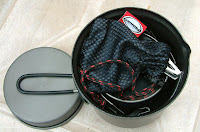 |
• Very fast boil time
• Low fuel consumption
• Environmentally friendly
• Extremely low total weight
• 2600W•8900 BTU/h

The EtaExpress Stove System comprises of 4 main elements; a 1L pot, a lid/frying pan, an express stove burner and a dedicated windshield.
All elements fit inside the 1L pot and this can also take a 100/250 gas cannister which then all go inside the supplied stuff sac.
One at a time
Burner - The burner is a typical 3 legged, screw on top gas burner, in fact it is the same one that I bought a couple of years ago, with the only difference being that this one has a Piezoelectric starter.
As expected from Primus the build quality is second to none, with strong sturdy pot legs and the gas control knob being made of a strong plastic, the electronic starter switch also has a robust feel to it. One thing to note is that the gas control and the starter are at 180° to each other and to fire the starter you pull the switch down.
1 Litre Pot and Lid/Frying Pan - Both the pot and lid are covered with a triple layer 'Titanium non-stick' surface. Both have grab handles attached; although the one on the lid can be removed. I much prefer the handles to be attached as it means I'm not constantly looking for a grab handle.
The 1l pot also has a heat exchanger attached to the bottom to help speed up cook times. Although the pot is 1l in size it's not much taller than my 750ml Vargo ti-pot and this helps to keep it pretty stable on the stove.
Most of my cooking is of the re-hydrate kind and usually only needs 300-400ml of water for this; so a 1l pot does seem to be quite big. Although saying that if there were two of us, it would probably be ideal.
Is it a lid? Is it a frying pan?
Eh; it's a lid. I do think that it is pushing it to call it a frying pan, yes you could fry an egg in it but you would struggle to get a couple of rashers in there.
Primus have come up with the idea of a windshield that clips to the gas cannister and help to protect the flame. This one is made of two pieces of metal held by another piece of spring loaded metal (this can be seen in the top photograph).
When all these elements come together they help to make the EtaExpress Stove a pretty fast stove, on the couple of times used I have had boil times around the 2-3 minute mark with a 100 cannister.
When the windshield is fitted to the gas cannister it is almost impossible to get to the starter switch.

I have tried this a couple of times and on one occasion I nearly pulled the lit stove on to me. After this I had a look around the internet to see if I was doing something wrong; although the picture on the box showed I did have the windshield fitted correctly.
Once on the net I found that there seems to be two different windshields and I'm guessing that one was the original design and the one I have is the newer design.
 New and Old designs
New and Old designsApart from this one problem the EtaExpress looks to be a very quick stove and the low weight (450g) makes it a good all round solo cooking system.




